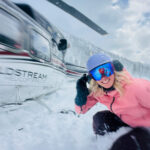from Short Turns in Buyer’s Guide 2015 issue
I have a new respect and awareness of Acute Mountain Sickness, or AMS, after a day of backcountry skiing in the Swiss Alps last March.
We started the day by climbing, with skins, about 600 vertical metres; it took three hours. Most of the exertion occurred just under 4,000 metres on the one-km-thick Alestch Glacier.
For the first 90 minutes, I was able to follow closely behind our mountain guide, but as we climbed steeper inclines, I developed a persistent dry cough, shortness of breath and a racing heart. Even frequent stops during our last hour of climbing produced little relief.
A few of my fellow skiers kindly tried to carry my pack for me when they could see how I was struggling, but I was too proud (or stupid) to give it up. Being overtaken by a 70-year-old Swiss woman—who was humming a tune as she passed—proved to be a truly humbling experience.
When I finally made it to the top of the pass, my gang had already finished lunch and were getting ready for the ski down into another valley and canton. Luckily, I was able to ski on my own without too much trouble. My symptoms resolved dramatically as we descended—but the cough lasted for two days.
Once I was back home in Toronto, I mentioned my adventure to several colleagues with experience in high-altitude medicine. It wasn’t until then that I realized my climb-induced symptoms were really High Altitude Pulmonary Edema (HAPE), where the lungs become “water-logged.” It can be fatal if you don’t descend to a lower altitude or supplemental oxygen is not available. My case was likely a mild one, since I was able to finish my climb and descent.
HAPE is far less common than the usual Acute Mountain Sickness (AMS)—headache, nausea, dizziness and trouble sleeping—but both conditions have similar causes. The most extreme version of AMS is High Altitude Cerebral Edema (HACE), where the brain actually swells, resulting in all the symptoms of AMS plus mental confusion. HACE is even more rare than HAPE and requires immediate treatment.
HAPE rarely occurs below elevations of 2,500 metres, and only a minority of people will develop HAPE at altitudes between 2,700 and 4,000 metres. I’m still not sure what made me so special.
Ironically, having a high level of cardiovascular fitness does not protect against AMS or HAPE. Athletes and couch potatoes can suffer equally.
Certain medications have been shown to prevent AMS in people at risk and could be obtained from your family physician prior to departure. Actetazolamide (a type of water pill) and dexamethasone (a cortisone pill) are the two medications that are most commonly used. Curiously, the commonly used erectile dysfunction medications, such as Viagra and Cialis, are also showing some promise in preventing AMS—just be careful on a crowded cable car.
Dr. John Foote is an emergency room physician at Toronto’s Mount Sinai Hospital.
Risk factors for HAPE or AMS for skiers:
› Rapid change in elevation, e.g. flying from sea level to the mountains
› Prior personal history of AMS
› Sleeping pills in the benzodiazepine family (ones that end in “pam”)
› Strenuous activity at elevation
› Having a bad chest cold when you arrive at elevation



